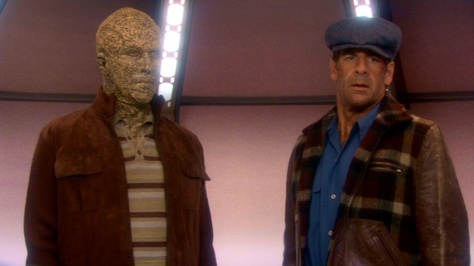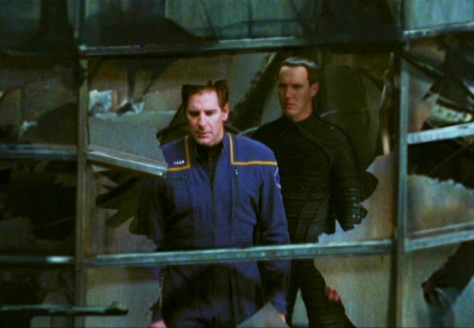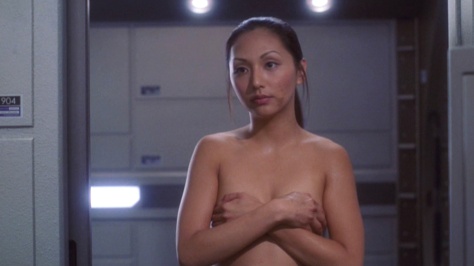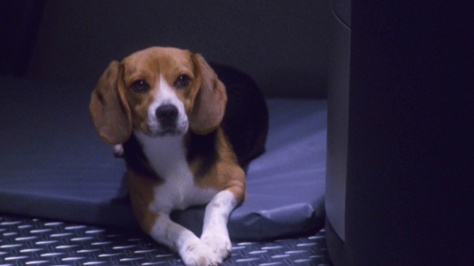
Part one: Enterprise is in orbit of Earth, but in the 1940s. Archer is alive and on the planet (unbeknownst to the crew) and is quickly rescued by American resistance fighters who assault a Nazi convoy … in New York state. We quickly learn that history’s been changed and that a faction from the Temporal Cold War is working with the Nazis, who have taken over most of the East Coast. A dying Daniels shows up and tells Enterprise what’s going on, and then Silik shows up and steals a shuttle and heads to the surface. Trip and Mayweather follow to try to capture him, and are then captured by Nazis. Meanwhile, Archer works with the resistance and meets one of the aliens, and uses that alien’s communicator to contact Enterprise and return to the ship. The episode ends as alien leader Vosk (Jack Gwaltney) inspects a time conduit he is building with the help of the Nazis.
Part two: The Nazis are growing impatient with Vosk’s dedicating resources to the time conduit and not the war. After interrogating Trip and Mayweather, Vosk contacts Archer and tries to get him to help his cause. Archer refuses and then rescues Mayweather and Trip from the Nazis — but quickly learns that Trip is actually Silik in disguise. Archer and Silik then beam to the surface to stop Vosk and rescue Trip (with the help of the American resistance fighters) before the conduit is destroyed, but Silik is killed in the process. Then, Archer meets Daniels (who died earlier in the episode) in a weird timey reset thing who tells him the timelines have been restored and that the Temporal Cold War is (finally and mercifully) over. Enterprise returns to its own time, with Earth out of danger.

Why it’s important
Although it’s a reset, I assume that Archer and Co. remember what happened in these two episodes, and in all the previous Temporal Cold War outings. As a result, they saved Earth twice in the span of a year (hell, in the span of about a week!). It is interesting, though, that in subsequent episodes mentioning the crew’s heroism, only the Xindi mission is referenced. Hmmm …

What doesn’t hold up
Following up on that point, did the the destruction of the time conduit end the Temporal Cold War to the point where it never happened in the first place? That seems hard to believe, but it’s certainly possible — though it would mean that there’s no explanation for Archer’s return to the ship after the Xindi weapon was destroyed among a myriad of other things in Enterprise’s first three seasons. Considering that the sphere builders were apparently involved with the TCW and that Archer and Co. remember all of season three …
There’s also the matter of how and when Daniels threw Archer and Enterprise back in time. For Archer, it must have happened right as the Xindi weapon exploded, and for Enterprise, when it arrived back in the Terran System — as we see interactions with the Xindi (presumably) in the 22nd century in the closing acts of “Zero Hour”.
Final thoughts
We had to include these episodes, because they’re consequential. But they’re not really good. Science fiction relies too much on Nazis, and the Temporal Cold War stuff just never made much sense. Scott Bakula’s line delivery in the final scene with Daniels almost makes it sound like he (Bakula) was tired of the plot line. That Daniels could die twice in the course of three seasons and end up being resurrected both times is nonsense that undercuts the drama. It’s worth noting that the best two seasons of Enterprise involved the least amount of TCW/Daniels, presuming you don’t include the entire Xindi arc under that umbrella.
As we’ve noted before, the creators of second-generation Trek kind of threw out the rule book when it came to time travel around the time Voyager started airing. Cause didn’t need to precipitate effect, etc. As a result, when time travel became common on Enterprise, it was bound to very little logic.
Moving on, we won’t review “Home”, the follow-up episode that covers the crew returning to Earth where they’re (rightly) greeted as heroes. From a character perspective, it’s important (sort of the equivalent of TNG’s “Family”) so it’s worth watching if you’re a fan. It’s also vintage Enterprise, in that it tried some interesting things but failed on execution. Notably, Archer’s mental anguish over his actions in the Expanse is WAY over the top (even to the point where he questions Starfleet’s existence!) and the T’Pol/Trip drama over T’Pol’s forced marriage wasn’t well done. The most important part of the episode might be the foreshadowing of xenophobia on Earth since the Xindi attacks.
It’s also interesting that Archer’s more questionable actions from season three are not addressed by his superiors or the Vulcans, at least, on screen.
Coming later this week …
Brent Spiner comes to Enterprise as the season of fan service begins.






